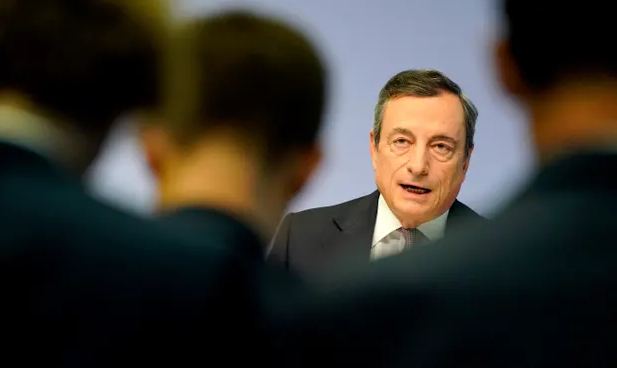Outgoing president says outlook is worsening and inflation is well below target
The European Central Bank has given a clear signal that it will join the US Federal Reserve in seeking to boost global growth as it expressed concern about flagging levels of activity and undershooting inflation in the eurozone.
Financial markets were left fully braced for a cut in interest rates from the ECB in September, together with a resumption of money creation under its quantitative easing programme.
The Fed is expected to cut US borrowing costs by a quarter point next week as an insurance policy against a possible economic downturn. Although the ECB left its interest rates unchanged at a meeting of its governing council in Frankfurt, it left investors in no doubt about its intentions.
Mario Draghi, the ECB’s outgoing president, said the outlook for eurozone growth was worsening and inflation remained well below the bank’s target. The ECB said it would use every weapon at its disposal to mitigate deflationary pressures.
The Bank of England’s monetary policy committee, which meets at the start of next month, is expected to leave interest rates unchanged at 0.75% until the outcome of Brexit has been determined.
Draghi, who will be replaced by Christine Lagarde when he leaves the ECB at the end of October, said at a press conference the economic outlook was getting “worse and worse” and that there was no sign of the pick-up in growth previously expected for the second half of 2020.
In a statement announcing its policy decision, the ECB said it anticipated interest rates being at their current level or even lower until the middle of 2020.
Up until now, the Bank’s guidance has been that interest rates will remain on hold and the toughening of its language sent the euro lower against the US dollar.
The ECB statement also omitted its standard reference to the objective of inflation being “below, but close to, 2%” over the medium term. Instead, it talked about a symmetrical target in which inflation above or below the 2% target would be given equal weight.
Draghi said: “The bottom line … is basically we don’t like what we see on the inflation front and symmetry means there is no 2% cap. Inflation can deviate on both sides.”
The ECB also prepared the way for a resumption of the money-creation process known as quantitative easing through the purchase of financial assets. Although additional QE has been resisted by some ECB council members, the Bank said it stood ready to “adjust all of its instruments, as appropriate, to ensure that inflation moves towards its aim in a sustained manner”.
The ECB’s pledge of more stimulus to come is designed to boost confidence and activity in the eurozone, which has been hard hit by the impact of the slowdown in the global economy on its export sector. Recent industrial output figures from Germany – the eurozone’s powerhouse economy – have heightened concerns that growth will ease back from the 0.4% recorded in the first three months of 2019.
The ECB said the current inflation rate of 1.3% was well below where it wanted it to be, underlining “the need for a highly accommodative stance of monetary policy for a prolonged period of time”.
The International Monetary Fund supported the ECB’s pledge to provide more stimulus in the coming months.
“The IMF staff support the ECB’s commitment to maintain strong accommodation in its monetary policy for a prolonged period of time, and its willingness to consider further accommodative steps, if necessary, together with a review of appropriate measures,” said the IMF spokesman Gerry Rice.
Jack Allen-Reynolds, senior Europe economist at Capital Economics, said it was clear that an easing of policy from the ECB was coming. He said he expected a cut in the Bank’s deposit rate from -0.4% to -0.5% in September and the resumption of QE in October. “The ECB is now edging, one step at a time, towards further loosening,” he said.

